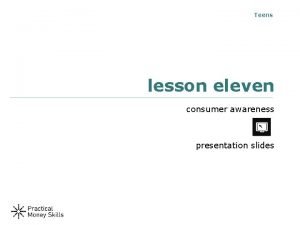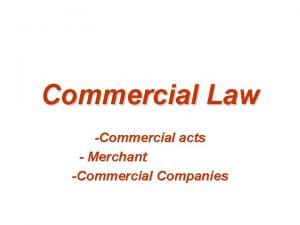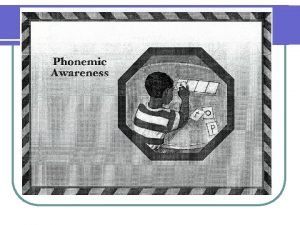Commercial Awareness Lesson 3 MA Written Exercise Overview














- Slides: 14

Commercial Awareness Lesson 3: M&A Written Exercise– Overview and Financing ASPIRING COMMERCIAL LAWYERS NETWORK IZZET HASSAN

Written Exercise M&A case study (popular) Contractual dispute Letter to a client Identify commercial issues

M&A Case Study Scenario relating to a company trying to grow its business / improve profitability Merger / Acquisition Merger: Two separate companies combine forces to create a new joint company (original companies no longer exist) Acquisition: Takeover of one company by another company Joint Venture: Two or more companies combine and share resources for the purpose of pursuing a specific goal (original companies still exist)

What does it involve? You may be asked to advise on whether it is a good idea based on the facts you are told OR The process: Financing: equity or debt finance Structure: share purchase agreement vs asset purchase agreement Contractual clauses: Warranties Representations Indemnities Undertakings

M&A and Business Growth Acquire talent and IP A business that possesses a good management and process systems will be beneficial to a buyer who wants to improve their own internal operations Leverage Synergies Cost synergies: cutting costs by taking advantage of overlapping operations or resources and consolidating them in one entity. Could integrate into the supply chain? Revenue synergies: create new opportunities to change market dynamics e. g. access to new markets, larger customer base, new complementary products and services, reduces competition. Add a new business model: If you’re considering changing it – why not buy one that is working and one you like. TRIED & TESTED. Save time: Considering adding a new service or product. Your company is able to develop but will take more time, money and resources than you want.

It may not be all good…. Risk of culture clash If the features and benefits offered by one company are not relevant to the other company, rather than adding to capabilities, it may serve to weaken the brand. Employee distress Loss of jobs? Loss of importance – part of a massive company However it is financed may affect the company

Your Approach Writing style Concise and direct Evidence (reference to facts) Structure Start with your answer i. e. what are you advising Focus on the benefits of your option. In a factual manner, explain why you believe it is the best choice. Based on facts, aim for 2 -3 well-developed points Consider the other options, but do not focus on their positives too much Good approach to take is ‘Whilst, option B may offer ……, the negative implications of…. . ’

Financing an M&A transaction Equity Finance: Raising capital through the sale of shares Public listed company: Easy Liquid Private Limited company: Allotting new shares. If you are offering a small number of shares, it may be easier to secure financing in this way Debt Finance: Raising capital through debt Loan: Company borrows money from lender. Makes interest payments and repays principal at end of loan term. Bonds: EXACTLY THE SAME but borrowed to institutional investors Issuer of the bond (company), owes the holder of the bond (investor) a debt. Debt consists of interest (the coupon) and the principal sum, which is paid at a later date (maturity date) Bonds can be bought and sold in the financial markets (bond market) Liquid, potentially lower interest rate, no restrictions as bank loans

Advantages of Equity Finance (1) Strengthens balance sheet (assets v liabilities) by reducing gearing, and therefore contributes to long-term stability of company Balance sheet shows assets vs liabilities Gearing is the ratio between a company’s long term debt and its equity (capital) When you take out a loan, liabilities section on balance sheet go up that gearing ratio is negatively affected When you sell shares, you equity to debt ratio (gearing) improves When the balance sheet looks good, it’s easier to secure more funding down the line Highly geared companies are seen as riskier companies by banks. If you get a financial statement in the written exercise, make use of it!

Advantages of Equity Finance (2) No repayment as there is no loan, no interest payments, no restrictions (buy-back shares / redeemable shares – but let’s not worry about that at this stage) Company only has to pay dividends when it’s making profit. Full capital can be employed for business growth In the case of a loan or bond – you have to pay interest irrespective of how the company is doing Banks can place financial obligations on company such as financial testing. No such restrictions with equity finance No security over assets unlike a loan. Banks will want to take security over the company’s assets to reduce risk

Advantages of Equity Finance (3) New investor who subscribes for shares is interested in the long-term profit of company and may be able to contribute expertise Drive growth No such benefit with a loan or bond Private limited companies, not the same for public listed companies

Disadvantages of Equity Finance (Company) Dilution of voting rights and dividend payments. When shares are issued, investors have certain voting rights attached to them and are entitled to dividend payments For this reason shareholders may resist this option Increasing number of shareholders, increases likelihood of disputes Shareholder consent typically required for issuing shares whereas no such consent is required for loans Dividends are not tax deductible where as interest payments under a loan are

What have we learnt? Differences between a merger, acquisition, joint venture How M&A can help businesses grow What will you do in your written exercise Advise on growth strategies Look at commercial issues and advise Raise capital: Equity Finance vs Debt Finance

Next steps… Enjoy the weekend! Tuesday 5 th November 2019 Application Questions Lesson 6: CVs Let’s get it.
 Cvs privacy awareness training answers
Cvs privacy awareness training answers Commercial food service operation
Commercial food service operation Chapter 9 lesson 2 photosynthesis an overview
Chapter 9 lesson 2 photosynthesis an overview Lesson overview
Lesson overview Lesson 11 consumer awareness answer key
Lesson 11 consumer awareness answer key Lesson eleven quiz consumer awareness
Lesson eleven quiz consumer awareness Go kiss the world mcq questions
Go kiss the world mcq questions Lesson outline lesson 3 describing circuits answers
Lesson outline lesson 3 describing circuits answers Mountain building
Mountain building Lesson outline lesson 2 aquatic ecosystems answer key
Lesson outline lesson 2 aquatic ecosystems answer key Micro lesson plans
Micro lesson plans Ihi leadership alliance
Ihi leadership alliance Gift of chappals lesson plan
Gift of chappals lesson plan An overall state of well-being or total health
An overall state of well-being or total health Weather forecast lesson 3 outline answers
Weather forecast lesson 3 outline answers



























